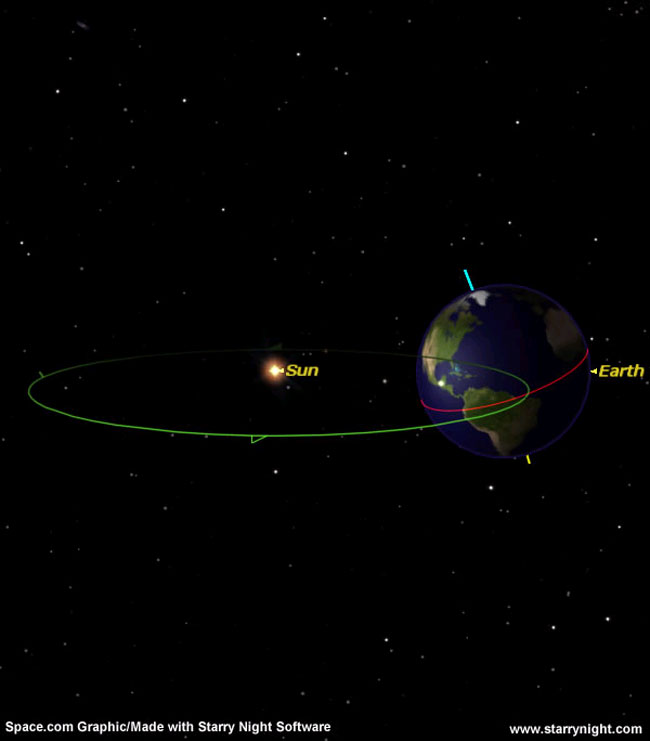
In the Northern Hemisphere, summer will officially begin at the solstice, on Thursday, June 21 at 2:06 p.m. EDT (11:06 a.m. PDT). The sun will reach the point where it’s furthest north of the celestial equator. Summer officially begins in the Northern Hemisphere and winter begins for the Southern Hemisphere.
At solstice, the sun will appear to be shining directly overhead for a point on the Tropic of Cancer (latitude 23.5 degrees north) to the north of the Yucatan Peninsula, over the open waters of the Gulf of Mexico.
This changing of the seasons takes place because the plane of Earth’s equator is tilted 23.5 degrees to our orbit around the sun.
How it works
During the course of the year, varying amounts of sunlight strike different regions of our planet. Both the angle of incidence of this radiation and the length of daylight change significantly. If the insolation alone – the total energy received from the sun – governed the temperature, we should be experiencing the year’s hottest weather right now.
But the atmosphere in temperate regions continues to receive more heat than it gives up to space, a situation that lasts a month or more, depending on the latitude. A reverse process occurs after the winter solstice in December. So for many places, the hottest part of the year comes in late July and the coldest in late January.
Here’s another example: In New York City on April 12 the insolation is exactly the same as on Aug. 31, but because of that seasonal lag, freezing temperatures are possible on the former date, while a 90-degree heat wave can occur on the latter.
Get the Space.com Newsletter
Breaking space news, the latest updates on rocket launches, skywatching events and more!
Daylight extreme
Solar heating also depends on the midday sun's altitude in the sky, which controls its daily path and the number of hours it’s above the horizon.
A northern city like Chicago can never see the sun directly overhead, but come Thursday at 12:52 p.m. CDT, the sun will attain its highest point in the sky over the Windy City for this entire year, standing 72 degrees above the southern horizon (a clinched fist at arm’s length measures roughly 10-degrees; so for Chicagoans, at its highest point, the sun is just over “seven fists” up from the southern horizon).
Since the sun now appears to describe such a high arc across the sky, the duration of daylight is now at its most extreme; at mid-northern latitudes, the sun is above the horizon for more than 15 hours. And north of the Arctic Circle (latitude 66.5-degrees north) the sun remains above the horizon 24-hours a day (the so-called “midnight sun” effect).
Myth busting
Finally, there’s a popular misconception that the Earth is now at its closest point in its orbit relative to the sun. That, however, is most definitely not the case.
In fact, on July 6th at 8:00 p.m. EDT, the Earth will arrive at aphelion, its farthest point from the sun in its orbit, at a distance of 94.5 million miles. Back on January 3rd, Earth was at perihelion, its closest to the sun. The difference between these two extremes is about 3.1 million miles or 3.3 percent, which makes a difference in radiant heat received by the Earth of nearly 7 percent.
Initially, it would seem that for the Northern Hemisphere such a difference would tend to warm the winters and cool the summers. The truth of the matter is, however, that the preponderance of large land masses in the Northern Hemisphere works the other way and actually tends to make the winters colder and the summers hotter.
- Online Sky Maps and More
- Sky Calendar & Moon Phases
- Astrophotography 101
Joe Rao serves as an instructor and guest lecturer at New York's Hayden Planetarium. He writes about astronomy for The New York Times and other publications, and he is also an on-camera meteorologist for News 12 Westchester, New York.
Join our Space Forums to keep talking space on the latest missions, night sky and more! And if you have a news tip, correction or comment, let us know at: community@space.com.

Joe Rao is Space.com's skywatching columnist, as well as a veteran meteorologist and eclipse chaser who also serves as an instructor and guest lecturer at New York's Hayden Planetarium. He writes about astronomy for Natural History magazine, Sky & Telescope and other publications. Joe is an 8-time Emmy-nominated meteorologist who served the Putnam Valley region of New York for over 21 years. You can find him on Twitter and YouTube tracking lunar and solar eclipses, meteor showers and more. To find out Joe's latest project, visit him on Twitter.









